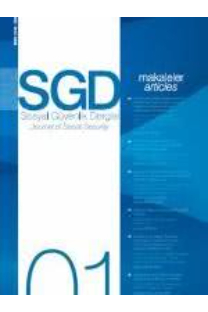Gelir Eşitsizliği ile Enflasyon İlişkisinin Gelişmişlik Düzeyine Göre Heterojen Panel Veri Modelleri ile Analizi
Analysis of the Relationship Between Income Inequality and Inflation with Heterogeneous Panel Data Models According to the Level of Developmend
___
- Agnello, L. ve Sousa, R. M. (2014). How Does Fiscal Consolidation Impact on Income Inequality? The Review of Income and Wealth. 60(4). 702-726.
- Alam, M. S. ve Paramati, S. R. (2016). The Impact of Tourism on Income Inequality in Developing Economies: Does Kuznets Curve Hypothesis Exist? Annals of Tourism Research. 61. 111-126.
- Argun, A. İ. (2016). Gelişmekte Olan Ülkelerde Finansal Gelişme ve Gelir Eşitsizliği. İstanbul Üniversitesi Sosyal Bilimler Dergisi (1). 61-74.
- Bach, G. L. ve Ando, A. (1957). The Redistributional Effects of Inflation. The Review of Economics and Statistics. 39(1). 1-13.
- Balcilar, M., Chang, S., Gupta, R. ve Miller, S. M. (2018). The Relationship between the Inflation Rate and Inequality Across U. S. States: A Semiparametric Approach. Quality and Quantity. 52(5).2413–2425.
- Beck, T., Demirgüç-Kunt, A. ve Levine, R. (2007). Finance, Inequality and the Poor. Journal of Economic Growth. 12(1). 27-49.
- Björklund, A. (1991). Unemployment and Income Distribution: Time-Series Evidence from Sweden. Wiley on Behalf of the Scandinavian Journal of Economics. 93(3). 457-465.
- Blinder, A. S. ve Esaki, H. Y. (1978). Macroeconomic Activity and Income Distribution in the Postwar United States. The Review of Economics and Statistics. 60(4). 604-609.
- Breusch, T. S. ve Pagan, A. R. (1980). The Lagrange Multiplier Test and its Applications to Model Specification in Econometrics. The Review of Economic Studies. 47(1). 239-253.
- Budd, E. C. ve Seiders, D. F. (1971). The Impact of Inflation on the Distribution of Income and Wealth. The American Economic Review. 61(2).128-138.
- Bulir, A. (2001). Income Inequality: Does Inflation Matter? IMF Staff Papers.Chu, K.-y., Davoodi, H. ve Gupta, S. (2000). Income Distribution and Tax and Government Social Spending Policies in Developing Countries. IMF Working Paper 00/62.
- Galli, R. ve van der Hoeven, R. (2001). Is Inflation Bad for Income Inequality: The Importance of the Initial Rate of Inflation. Employment Paper 2001/29.
- Hermes, N. (2014). Does Microfinance Affect Income Inequality? Applied Economics. 46(9). 1021-1034.
- Jalil, A. (2012). Modeling Income Inequality and Openness in the Framework of Kuznets Curve: New Evidence from China. Economic Modelling. 29(2). 309–315.
- Jäntti, M. ve Jenkins, S. P. (2001). Examining the Impact of Macro-Economic Conditions on Income Inequality. Bonn: Discussion Paper No. 364.
- Jauch, S. ve Watzka, S. (2016). Financial Development and Income Inequality: A Panel Data Approach. Empirical Economics. 51(1). 291-314.
- Kuznets, S. (1955). Economic Growth and Income Inequality. The American Economic Review. 45(1). 1-28.
- Law, C.-H. ve Soon, S.-V. (2020). The Impact of Inflation on Income Inequality: The Role of Institutional Quality. Applied Economics Letters. 1-4.
- Maurer, M. R. veYeşin, P. A. (2004). Income Inequality and Inflation. Swiss National Bank Working Papers.Meh, C. A. ve Terajima, Y. (2009, Spring). Unexpected Inflation and Redistribution of Wealth in Canada. Bank of Canada Review
- Monnin, P. (2014). Inflation and Income Inequality in Developed Economies. CEP Working Paper 2014/1.
- Nantob, N. (2015). Income Inequality and Inflation in Developing Countries : An Empirical Investigation. Economics Bulletin. 35(4). 2888-2902.
- Park, C.-Y. ve Mercado, R. V. (2015). Financial Inclusion. Poverty, and Income Inequality in Developing Asia. Adb Economics Working Paper Series No. 426.
- Pesaran, M. H. ve Smith, R. (1995). Estimating Long-Run Relationships from Dynamic Heterogeneous Panels. Journal of Econometrics. 68(1). 79-113.
- Rueda, M. C. (2008). Inequality, Democracy and Inflation. Swiss National Bank.Samuelson, P. A. ve Nordhaus, W. D. (2010). Economics. New York: McGraw-Hill.Siami-Namini, S. ve Hudson, D. (2019). Inflation and Income Inequality in Developed and Developing Countries. Journal of Economic Studies. 46(3). 611-632.
- Sieron, A. (2017). Inflation and Income Inequality. Prague Economic Papers. 26(6). 633–645.
- Swamy, P. (1971). Statistical Inference in Random Coefficient Regression Models. New York: Springer.Thalassinos, E., Uğurlu, E. ve Muratoğlu, Y. (2012). Income Inequality and Inflation in the EU. European Research Studies. 15(1). 127-140.
- Topuz, S. G. veDağdemir, Ö. (2016). Ekonomik Büyüme ve Gelir Eşitsizliği İlişkisi: Kuznets Ters-U Hipotezi’nin Geçerliliği. Eskişehir Osmangazi ÜniversitesiİİBF Dergisi. 11(3). 115-130.
- Topuz, S. G. veDağdemir, Ö. (2016). Finansal Gelişme ve Gelir Eşitsizliği: Bir Panel Veri Analizi. Anadolu Üniversitesi Sosyal Bilimler Dergisi. 16(3).19-34.
- Yerdelen Tatoğlu, F. (2020). İleri Panel Veri Analizi Stata Uygulamalı. 4. Baskı. İstanbul: Beta Basım Yayım Dağıtım.Yoshino, O. (1993). Size Distribution of Workers' Household Income and Macroeconomic Activities in Japan: 1963-88. Review of Income and Wealth. 39(4). 387-402.
- Yue, H.-Y. (2011). Income Inequality, Economic Growth and Inflation: A Study on Korea. International Journal of Economics and Research. 2(5).14-21.
- Zellner, A. (1962). An Efficient Method of Estimating Seemingly Unrelated Regressions and Tests for Aggregation Bias. Journal of the American Statistical Association. 57(298). 34
- ISSN: 2146-4839
- Yayın Aralığı: 2
- Başlangıç: 2011
- Yayıncı: SOSYAL GÜVENLİK KURUMU
Gig Ekonomisinde İstihdam ve Endüstri İlişkileri: İstihdam Statüsünden Kaynaklanan Zorluklar
3201 Sayılı Kanun’a Göre Yapılacak Yurt Dışı HizmetBorçlanmasında Aylık Bağlama Koşulları
Ömer Fazıl EMEK, Ferda YERDELEN TATOĞLU
Gri Markov Modeli ile Türkiye’de İşsizlik Oranı Tahmini
Deniz KOÇAK, Yasin ERTÜRK, Murat ATAN
Bireysel Emeklilik Sistemine Analitik Bakış: Yoğunlaşma ve Yapısal Kırılma Analizi
Harun Türker KARA, Harun TÜRKER KARA
Kamu Harcama Türleri ile İnsani Gelişme Arasındaki İlişki: Avrupa Ülkeleri Örneği (2009 - 2018)
